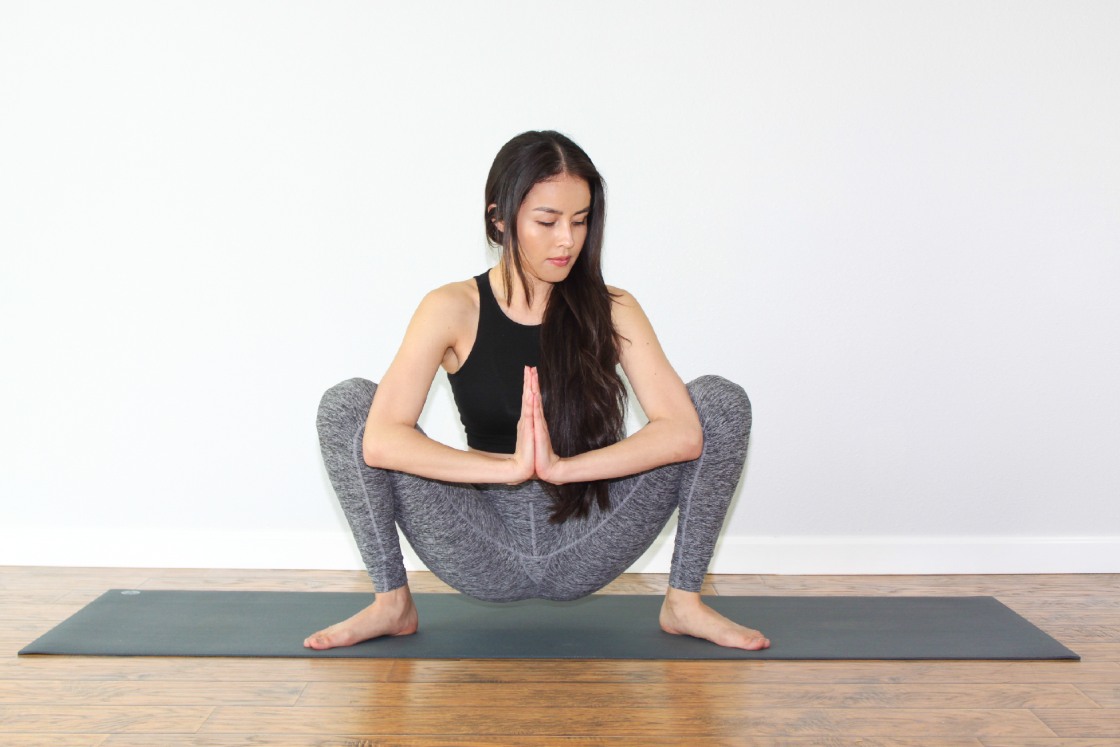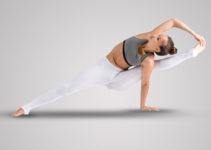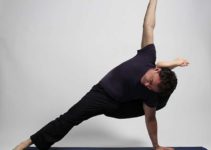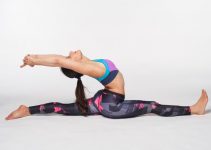
| Sanskrit Pronunciation | Malasana – Maa-laa-sa-na (मालासन) |
| Meaning | Mala – Garland Asana – Pose |
| Pose Type | Sitting & Hip opener |
| Pose Level | Beginner, 30 seconds to 1 minute |
| Beneficial in | Strengthening legs, thighs, hips, and lower back |
| Known as | Squat pose, Garland pose |
Lower body flexibility or hip stiffness is very common among newbie yogis. In this article, you will see an asana, which is very restorative for hips and thighs, The asana is Garland Pose (Malasana).
Table of Contents
- Garland Pose: Malasana
- How to Do Garland Pose
- Modifications and Prop Use
- Benefits of Garland Pose
- Precautions and Contraindications
Garland Pose: Malasana
Garland Pose is an easy and beginner level squatting asana. It is a gentle hip opener exercise that is very helpful for your metabolism. Malasana is a part of Vinyasa Yoga sequences, that is especially helpful for the people with tight hips and stuffy lower part of the body.
Garland Pose works amazingly on digestion and excretion of waste. So, this asana is very helpful for the patients of indigestion and constipation.
Garland Pose focuses on the following muscles:
- Lower back
- Hips
- Hamstrings
- Knees and ankles
In this posture our hands look like a garland/Mala hanging on our neck, that is why we call it Garland Pose.
Rather, it is a little difficult to relate the body posture to a garland. On the other hand, we can also relate the word Mala with excrement. In India, a similar pose is used while excretion. Also, considering its benefits to the digestive system, this reason to call it Malasana is more sensible.
Now, let’s roll out our yoga mats and get into the Garland Pose or Malasana.
How to Do Malasana
Step 1
Roll out a yoga mat and stand over it in Tadasana. Spread your feet slightly wider than your hip-width.
Step 2
Exhale, bend your knees and lower your hips towards the floor. Bring the hips down until they reach a few inches above the floor.
Step 3
Now, inhale and spread your thighs & knees wider, a little wider than your torso. Exhale and lean your torso forwards, a little, between your thighs and knees.
Step 4
Bring your palms together and bring them near your chest as in Namaste (Anjali Mudra). Meanwhile, press your triceps against the inner thigh. Close your eyes for better concentration.
Hold this position for 30 to 60 seconds and take deep breaths for a better flow of prana.
Checkpoints
- Your spine should be straight and stretched.
- Your shoulders must be wide.
- The chest should be expanded.
- Toes must be pointing forwards.
- Keep the head straight and stretch the neck.
Step 5
When you are done, take a long, deep breath, exhale, and release the hands. Now, either push down with feet and stand or sit back and relax.
This is one round of the Garland Pose. You can repeat it up to 3 times in a single session.
Modification and Props
- There are chances that your heels might come up while getting into the pose. So, in order to maintain balance, you can place a folded blanket under your feet.
- Also, placing a yoga block under each foot makes this asana more comfortable.
- In the beginning, you can perform this asana against the wall for better support.
- Getting into the exactly right posture is very important. So, consider taking the help of a friend or yoga teacher to get into this asana.
- To intensify the Garland Pose, place one hand firmly on the floor, between your feet, and raise another hand upwards while twisting the torso.
Preparatory Poses
- Hero Pose (Virasana)
- Butterfly pose (Baddha Konasana)
Follow-up Poses
- Standing forward bend (Uttanasana)
- Down dog pose (Adho Mukha Svanasana)
- Cobra pose (Bhujangasana)
Benefits of Malasana(Garland Pose)
- This asana is very soothing for the lower back. Practicing this pose relieves your lower back pain and brings flexibility in it.
- Garland Pose puts a good amount of pressure on your hips, hence it’s a good preparatory pose to open the hips and removes the stiffness from the hips.
- It is believed the most of the tension and stress of the body is stored in the hips. This asana is highly beneficial in removing this stress and tension, which is stored in the hips.
- Bending the knees works on the muscles around the knees. Practicing this asana tones the muscles and tissues around the knees.
- Malasana puts your belly muscles into work. It massages the abdominal organs and tones them. This asana improves the whole metabolism of the body.
- Also, through the massage of the whole digestive system, Garland Pose improves the digestion of the body. This asana is very helpful in eliminating the problem of constipation.
- As most of the stretch applies on the thighs, hamstring, and calves, this asana makes these parts stronger and flexible. Besides, it removes stiffness of the whole let including ankles.
- This asana stimulates the Apana Vayu, which is a downward moving life force. Thus, this asana helps in excretion of the waste from the body.
- Garland Pose has a lot to do with your sitting posture and body shape. Regular practice of this asana amazingly enhances your body posture.
- This asana elevates your self-esteem. It brings self-awareness within you and promotes confidence.
Precautions and Contraindications
- It is important to practice this asana with an empty stomach. So, perform it in the morning time with an empty stomach or after at least 4 hours after having a meal.
- Do not put the whole weight on your toes or heels. This would not be good for your feet. Instead, spread the whole body weight evenly throughout the whole feet.
- Get into the Malasana slowly and gently. Do not perform this asana in a hurry.
- Do not overdo this asana in a single session. Perform it gently for limited minutes.
- Do not perform Garland Pose if you have chronic lower back pain or knee pain. Practicing this asana in such conditions can be painful.
- If you have medical conditions related to your spine, hips, or legs, concern your doctor trying this asana.
- Do not perform Malasana immediately after running. As the tissue around knees, ankles, and calves are heated up highly, so, putting pressure upon them is not a wise idea.
- If you have a recent or deep injury on your back, hips knees, ankles, or feet, do not perform this asana at all.
Can Garland Pose could be performed during pregnancy?
Yes, Garland Pose can be performed during pregnancy. Rather it is among those asanas which you can perform during pregnancy, without any hesitation. Just make sure, do not put excessive pressure on the abdomen region.
For whom Garland Pose/Malasana is most beneficial?
Garland Pose/Malasana is most beneficial for those who have desk jobs or who sit for prolonged periods. As this asana focuses on the lower spine and hips, it is very soothing for them.




